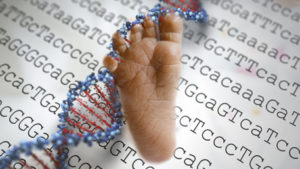A Strong Start: Enhancing Newborn Screening for Precision Public Health
Stephanie Garcia; David Jones; Nicole Rulz-Schultz; Amy Gaviglio and Carla Cuthbert | October 15, 2020
 As the capability to sequence an individual’s genome or exome continues to expand—and the cost continues to fall—more states are considering how next generation sequencing (NGS) could support their newborn screening programs, which test approximately four million babies born in the United States each year for congenital, treatable diseases.
As the capability to sequence an individual’s genome or exome continues to expand—and the cost continues to fall—more states are considering how next generation sequencing (NGS) could support their newborn screening programs, which test approximately four million babies born in the United States each year for congenital, treatable diseases.
Results from NGS can help enhance newborn screening programs by providing more information beyond traditional biochemical and other tests. Not all states have the expertise needed to interpret NGS results, but the Centers for Disease Control and Prevention (CDC) is developing the Enhancing Data-driven Disease Detection in Newborns (ED3N) system, which has the potential to help. ED3N is being designed to enable secure upload of NGS data in any format and could benefit from data standards that address efficiency and interoperability. A recent pilot project supported by the Department of Health and Human Services Office of the National Coordinator for Health Information Technology (ONC), confirmed that an existing open-source data standard (Health Level 7 International® (HL7®) Fast Healthcare Interoperability Resources® (FHIR®) can successfully be used to transmit newborn screening NGS data.
A Pilot Project on FHIR®

The pilot project was conducted by the Utah Department of Health as part of ONC’s Sync for Genes project, which supports the Precision Medicine Initiative. Sync for Genes aims to advance data standards that support sharing NGS information to help patients and providers make better decisions. For example, providers can use NGS data to help patients and families—including parents of newborns—plan the best type of care based on the patient’s unique genetic information.
Utah is currently in the process of expanding the state’s newborn screening program by adding NGS for second-tier testing following an initial result that indicates a baby may have a genetic disorder. This second analysis only includes genes that are involved in that specific genetic disorder. If no unusual results are identified, the analysis can be expanded with parental consent to other genes and the entire exome sequence. Results from this NGS method may require interpretation by a clinical specialist to determine the best course of treatment.
Most genomic diagnostic reports are still provided in paper or PDF format, but the Sync for Genes pilot project tested whether FHIR® could be used to transmit the raw NGS data electronically. While diagnostic reports include result interpretations, they do not include raw data. This makes it difficult for patients and providers to share these data with a care team or specialists. FHIR® can be used to send various types of health information in a format that supports interoperability and that is increasingly being implemented across clinical and research environments. Since these data are machine readable, specialists can more easily use knowledge bases or visualization software to detect relationships and patterns that would have been difficult to previously identify.
The Utah pilot project team successfully tested the process of sending FHIR® messages from one server to another with five use cases that can arise in newborn screening:
- Two cases of cystic fibrosis,
- A cystic fibrosis carrier,
- A newborn with both cystic fibrosis and phenylketonuria, and
- A newborn with normal test results
As a result of the successful pilot, Utah plans to implement FHIR® as a method to transmit newborn NGS data, when necessary, for its screening program—including to centralized resources like ED3N—and other states that are adding more informatics capacity could follow.
A Strong Start with ED3N
Once ready, the ED3N platform will receive de-identified sequencing data from state newborn screening programs across the country. CDC’s experts will facilitate data interpretation and allow for national comparisons between programs. The data hub is designed to become a national resource for improving the precision of newborn screening, a vital public health service. Seven states and one Canadian territory are currently beta-testing the system with CDC.
ED3N has the potential to offer state newborn screening programs a secure portal for upload of NGS, molecular, and biochemical data in any format. Adoption of the FHIR® standard, as demonstrated in Utah, offers an efficient, streamlined solution for states to organize and transmit these data. With FHIR®, programs could seamlessly and securely send NGS, molecular, and biochemical data to ED3N and receive prompt interpretation results in the same format, with less manual work to organize the data along the way. Ultimately, this information could help state programs connect a family with early intervention that changes their baby’s life. ED3N is one important step toward precision public health.
Read more about the Utah newborn screening pilot project in the Sync for Genes Phase 2 Final Report.


